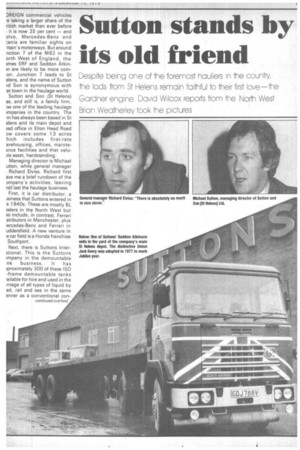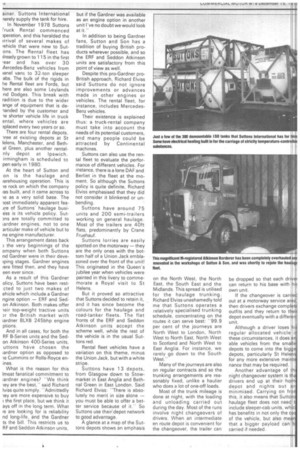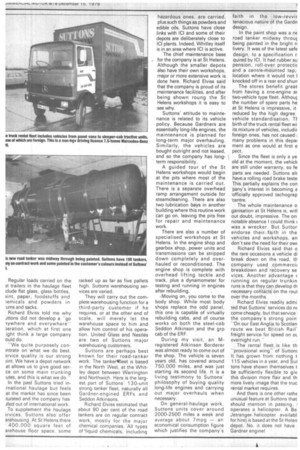Sutton stands by its old friend
Page 63

Page 64

Page 65

If you've noticed an error in this article please click here to report it so we can fix it.
Despite being one of e foremost hauliers in ne coun-ry, e lacs from St Helens remain fai ful to their first love---)e Gardner engine, Dayia Wilcox repot from e No West 3rian Wea erley took e oictures DREIGN commercial vehicles -e taking a larger share of the ritish market than ever before it is now 25 per cent — and olvo, Mercedes-Benz and ania are familiar sights on -itain's motorways. But around nction 7 of the M62 in the orth West of England, the 3mes ERF and Seddon Atkinin are likely to be more cornon. Junction 7 leads to St elens, and the name of Sutton -id Son is synonymous with ,at town in the haulage world. Sutton and Son St Helens) as, and still is, a family firm, 3).4, one of the leading haulage )mpanies in the country. The -m has always been based in St elens and its main depot and aad office in Elton Head Road ow covers some 13 acres hich includes first-rate arehousing, offices, mainteance facilities and that valu)le asset, hardstanding.
Managing director is Michael utton, while general manager Richard Elviss. Richard first ave me a brief rundown of the ompany's activities, leaving ntil last the haulage business. First, it is car distributor, a Jsiness that Suttons entered in e 1940s. These are mostly BL aalers in the North West but so include, in contrast, Ferrari stributors in Manchester, plus lercedes-Benz and Ferrari in uddersfield. A new venture ih le car field is a Honda franchise Southport.
Next, there is Suttons Interational. This is the Suttons )mpany in the demountable nk business. It has )proximately 300 of these ISO -frame demountable tanks railable for hire and used in the irriage of all types of liquid by ad, rail and sea in the same anner as a conventional con ainer. Suttons International ierely supply the tank for hire.
In November 1978 Suttons Fruck Rental commenced )peration, and this heralded the irrival of several makes of Thiele that were new to Sutons. The Rental fleet has ilready grown to 115 in the first ,ear and has over 30 dlercedes-Benz vehicles from ianel vans to 32-ton sleeper abs. The bulk of the rigids in he Rental fleet are Fords, but here are also some Leylands nd Dodges. This break with radition is due to the wider 3nge of equipment that is de-landed by the customer and
le shorter vehicle life in truck ental, where vehicles are ?placed every two years or so.
There are four rental depots, lree at existing depots at St lelens, Manchester, and Bethel Green, plus another rentalnly depot at Ipswich. irmirigham is scheduled to pen early in 1980.
At the heart of Sutton and on is the haulage and farehousing operation. This is le rock on which the company as built, and it came across to le as a very solid base. The lost immediately apparent feaire of Suttons' haulage busiess is its vehicle policy. Sut)ns are totally committed to iardner engines, not to one articular make of vehicle but to ne engine manufacturer.
This arrangement dates back ) the very beginnings of the ompany when both Suttons nd Gardner were in their deveTing stages. Gardner engines fere fitted then, and they have een ever since.
As a result of this Gardner olicy, Suttons have been restcted to just two makes of ehicle which include a Gardner ngine option — ERF and Sedon Atkinson. Both makes offer leir top-weight tractive units Dr: the British market with iardner 8LXB 245bhp engine ptions.
And in all cases, for both the RF B-Series units and the Sedon Atkinson 400-Series units, uttons have chosen the lardner option as opposed to le Cummins or Rolls-Royce enines.
What is the reason for this 'most fanatical commitment to !ardner engines? "We think ley are the best,said Richard lviss quite simply; Admittedly ley are more expensive to buy the first place, but we think it ays off in the long term. What ee are looking for is reliability nd long-life, and the Gardner ts the bill. This restricts us to RF and Seddon Atkinson units,
but if the Gardner was available as an engine option in another unit I've no doubt we would look at it.'
In addition to being Gardner fans, Sutton and Son has a tradition of buying British products wherever possible, and so the ERF and Seddon Atkinson units are satisfactory from this point of view as well.
Despite this pro-Gardner proBritish approach, Richard Elviss said •Suttons do not ignore improvements or advances made in other engines or vehicles. The rental fleet, for instance, includes MercedesBenz vehicles.
Their existence is explained thus: a truck-rental company must take into account the needs of its potential customers, and many people could be attracted by Continental machines.
Suttons can also use the rental fleet to evaluate the performance of different vehicles. For instance, there is a lone DAF and Berliet in the fleet at the moment. So although the Suttons policy is quite definite, Richard Elviss emphasised that they did not consider it blinkered or unbending.
Suttons have around 75 units and 200 semi-trailers working on general haulage. Most of the trailers are 40ft flats, predominantly by Crane Fruehauf.
Suttons lorries are easily spotted on the motorway — they are the only ones with the bottom half of a Union Jack emblazoned over the front of the unit! This originated in the Queen's jubilee year when vehicles were painted in this livery to commemorate a Royal visit to St Helens.
But it proved so attractive that Suttons decided to retain it, and it has since become the colours for the haulage and road-tanker fleets. The flat fronts of the ERF and Seddon Atkinson units accept the scheme well, while the rest of the vehicle is in the usual Suttons red.
Rental fleet vehicles have a variation on this theme, minus the Union Jack, but with a white stripe.
Suttons have 13 depots, from Glasgow down to Stowmarket in East Anglia and Bethnal Green in East London. Said Richard Elviss: "There is absolutely no merit in size alone — you must be able to offer a better service because of it." So Sultans use their depot network to good advantage.
A glance at a map of the Suttons depots shows an emphasis
on the North West, the North East, the South East and the Midlands. This spread is utilised for the haulage trunking. Richard Elviss unashamedly told me that Suttons operates a relatively specialised trunking schedule, concentrating on the routes it can serve best: "99.9 per cent of the journeys are North West to London, North West to North East, North West to Scotland and North West to East Anglia. For instance, we rarely go down to the South West.
Many of the journeys are also on regular contracts and so the trunking arrangements are reasonably fixed, unlike a haulier who does a lot of one-off loads.
Most of the trunk mileage is done at night, with the loading and unloading carried out during the day. Most of the runs involve night changeovers of drivers. When an intermediate en route depot is convenient for the changeover, the trailer can be dropped so that each driver can return to his base with hit own unit.
If the changeover is carrie out at a motorway service area then drivers exchange complet' outfits and they return to thei depot eventually with a differert unit.
Although a driver loses hi regular allocated vehicle i these circumstances, it does el able vehicles from the small depots to come into the bigg depots, particularly St Helen for any more extensive maint nance that may be required.
Another advantage of th night changeover system is th drivers end up at their .ho depot and nights out a minimised. Carrying on fro this, it also means that Sutton haulage fleet does not need include sleeper-cab units, whic has benefits in not only the co of the vehicle, but also melt that a bigger payload can carried if needed. Regular loads carried on the 3t trailers in the haulage fleet elude flat glass, glass bottles, lint, paper, foodstuffs and lemicals and powders in 'urns and sacks.
Richard Elviss told me why Jttons did not develop a "go iywhere and everywhere" Jeration, which at first one ight think a large company ould do.
"We quite purposely conmtrate on what we do best. arvice quality is our strong )int. We have a depot network at allows us to give good serce on some main trunking .utes, and this is what we do."
In the past Suttons tried inrnational haulage but feels at the market has since been iturated and the company has illed out of international work.
To supplement the haulage Suttons also offer arehousing. At St Helens there 400,000 square feet of arehouse floor space, some racked up as far as five pallets high. Suttons warehousing services are varied.
They will carry out the complete warehousing function for a third-party customer if he requires, or at the other end of scale, will merely let the warehouse space to him and allow him control of his operation. United Glass and Nestles are two of Suttons major warehousing customers.
Suttons are perhaps best known for their road-tanker work. The tankermfleet is based in the North West, at the Whitley depot between Warrington and Northwich. Here is the largest part of Suttons' 130-unit strong tanker fleet, naturally all Gardner-engined ERFs and Seddon Atkinsons.
Richard Elviss estimated that about 90 per cent of the road tankers are on regular contract work, mostly for the major chemical companies. All types of 'liquid chemicals, including hazardous ones, are carried, plus such things as powders and edible oils. Suttons have close links with ICI and some of their depots are deliberately close to ICI plants. Indeed, Whitley itself is in an area where ICI is active.
The chief maintenance base for the company is at St Helens. Although the smaller depots also have their own workshops, major or more extensive work is done here. Richard Elviss said that the company is proud of its maintenance facilities, and after being shown roung the St Helens workshops it is easy to ,see why.
Suttons' attitude to maintenance is related to its vehicle policy. Because Gardners are essentially long-life engines, the maintenance is planned for long-term major overhauling. Similarly, the vehicles are bought outright and not leased, and so the company has longterm responsibility.
A guided tour of the St Helens workshops would begin at the pits where most of the maintenance is carried out. There is a separate overhead ramp arrangement outside for steamcleaning. There are also two lubrication bays in another 'building where this routine work can go on, leaving the pits free for repair and maintenance work.
There are also a number of specialised workshops at St Helens. In the engine shop and gearbox shop, power units and transmissions can be stripped down completely and overhauled or reconditioned, The engine shop is complete with overhead lifting tackle and track, plus a dynamometer for testing and running in engines after rebuilding.
• Moving on, you come to the body shop. While most body shops replace the odd panel, this one is capable of virtually rebuilding cabs, and of course works on both the steel-cab Seddon Atkinson and the grp cab of the ERF.
During my visit, an registered AtkinsonAtkinson Borderer was almost ready to come out of the shop. The vehicle is seven years old, has covered around 750,000 miles, and was just starting its second life. It is a living testimony to Suttons' philosophy of buying quality long-life engines and carrying out major overhauls when necessary.
On general-haulage work, Suttons units cover around 2000-2500 miles a week and average about 7mpg — an economical consumption figure which justifies the company's faith in the low-revvir tenacious nature of the Gardn design.
In the paint shop was a nE road tanker midway throuc being painted in the bright n livery. It was of the latest safe design, to a specification r quired by ICI. It had rubber su pension, roll-over protectic and a centre-mounted tap; location where it would not knocked off in a rear end shun The stores benefit great from having a one-engine ar two-vehicle type fleet. Althouc the number of spare parts he at St Helens is impressive, it reduced by the high degree vehicle standardisation. birth of the truck rental fleet wi its mixture of vehicles, includir foreign ones, has not caused many problems in this depai meet as one would at first e pect.
Since the fleet is only a ye old at the moment, the vehich are still under warranty, so fe parts are needed. Suttons als have a rolling road brake teste This partially explains the con 'pany's interest in becoming a officially approved tachograp 'centre.
The whole maintenance o ganisation at St Helens is, witl out doubt, impressive. The on notable absence I could think c was a wrecker. But Suttor endorse their faith in the vehicles and workshops, an don't see the need for their owr Richard Elviss said that o the rare occasions a vehicle di break down on the road, th company used commercir breakdown and recovery se vices. Another advantage c running on regular trunkin runs is that they can develop th necessary contacts on the rout over the months.
Richard Elviss readily adrni ted that Suttons' services do nc come cheaply, but that service the company's strong poin• "On our East Anglia to Scotian route we beat British Rail' freight service for speed on overnight run."' The rental fleet is like th "provisional wing" of Suttont It has grown from nothing t 115 vehicles in a year, and Sul tons have shown themselves t be sufficiently flexible to giv this division more flair and th more lively image that the truc rental market requires.
And there is one other raffle unusual feature at Suttons that should mention in passing. I operates a helicopter. A Be Jetranger helicopter availabl for hire) is based at the St Helen depot. No, it does not have Gardner engine!




















































































































